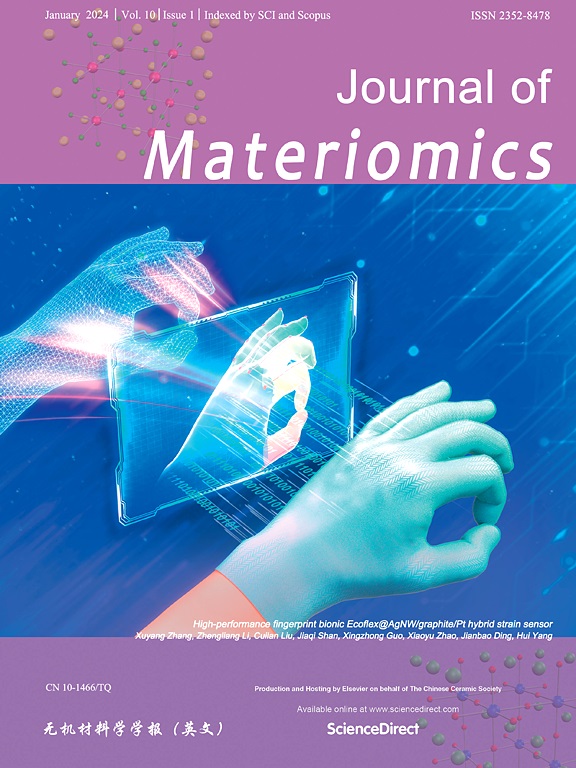High breakdown electric field and ultralow loss in Sb+Ho co-doped TiO2 giant dielectric ceramics induced by strongly coupled defect clusters
IF 8.4
1区 材料科学
Q1 CHEMISTRY, PHYSICAL
引用次数: 0
Abstract
Achieving a large dielectric constant and high breakdown electric field simultaneously has been a hot and difficult topic for co-doped TiO2 ceramics. In this study, (Sb0.5Ho0.5)xTi1–xO2 (SHTOx, x = 0, 0.01, 0.02, 0.04 and 0.06) ceramics with strongly coupled defect clusters were prepared to improving the dielectric and breakdown properties. In particular, the SHTO0.01 ceramic exhibits CP (ε′ = 1.61 × 104, 1 kHz), ultralow loss (tanδ = 0.0037, 1 kHz), excellent DC bias (0–400 V/cm) and thermal stability (Δε′/ε′25 °C ≤ ±15% at 1 kHz, −145 to 215 °C). Besides, high dielectric breakdown properties (Eb ∼2.287 kV/cm and α = 7.24) was also achieved. Meanwhile, the mechanism of achieving excellent overall properties was deeply explored by XPS, UDR law, impedance spectroscopy and relaxation behavior analysis. The high dielectric and breakdown field strength performances mainly originate from the strongly coupled defective dipole clusters and the highly insulating grain boundaries as well as electrode-ceramic interfaces, which synergistically restrict the long-range movement of free electrons. This research indicates that the construction of defect clusters with strong coupling is an effective approach towards obtaining CP ceramics with ultra-low loss and high breakdown field strength performances.

强耦合缺陷团簇诱导Sb+Ho共掺TiO2巨介电陶瓷的高击穿电场和超低损耗
同时获得大介电常数和高击穿电场一直是共掺杂TiO2陶瓷研究的热点和难点。本研究制备了具有强耦合缺陷团簇的(Sb0.5Ho0.5) xTi1-xO2 (SHTOx, x = 0, 0.01, 0.02, 0.04和0.06)陶瓷,以改善其介电和击穿性能。特别是,SHTO0.01陶瓷具有CP (ε′= 1.61 × 104, 1 kHz)、超低损耗(tanδ = 0.0037, 1 kHz)、优异的直流偏置(0-400 V/cm)和热稳定性(Δε′/ε′25°C≤±15%,1 kHz, - 145 ~ 215°C)。此外,还获得了高介电击穿性能(Eb ~ 2.287 kV/cm, α = 7.24)。同时,通过XPS、UDR定律、阻抗谱和弛豫行为分析等手段,深入探讨了获得优异综合性能的机理。高介电和击穿场强性能主要来源于强耦合的缺陷偶极子团簇和高度绝缘的晶界以及电极-陶瓷界面,它们共同限制了自由电子的远距离运动。研究表明,构建强耦合缺陷团簇是获得具有超低损耗和高击穿场强性能的CP陶瓷的有效途径。
本文章由计算机程序翻译,如有差异,请以英文原文为准。
求助全文
约1分钟内获得全文
求助全文
来源期刊

Journal of Materiomics
Materials Science-Metals and Alloys
CiteScore
14.30
自引率
6.40%
发文量
331
审稿时长
37 days
期刊介绍:
The Journal of Materiomics is a peer-reviewed open-access journal that aims to serve as a forum for the continuous dissemination of research within the field of materials science. It particularly emphasizes systematic studies on the relationships between composition, processing, structure, property, and performance of advanced materials. The journal is supported by the Chinese Ceramic Society and is indexed in SCIE and Scopus. It is commonly referred to as J Materiomics.
 求助内容:
求助内容: 应助结果提醒方式:
应助结果提醒方式:


